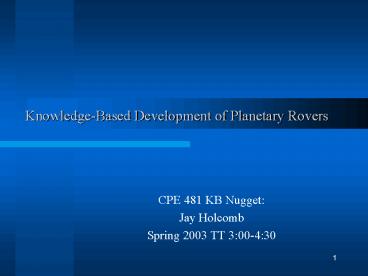KnowledgeBased Development of Planetary Rovers - PowerPoint PPT Presentation
1 / 14
Title:
KnowledgeBased Development of Planetary Rovers
Description:
... between rover and Expert. When reaches a steady and non-decreasing value the rover is then ... 3) http://telerobotics.jpl.nasa.gov/ 4) http://mars.jpl.nasa.gov ... – PowerPoint PPT presentation
Number of Views:30
Avg rating:3.0/5.0
Title: KnowledgeBased Development of Planetary Rovers
1
Knowledge-Based Development of Planetary Rovers
- CPE 481 KB Nugget
- Jay Holcomb
- Spring 2003 TT 300-430
2
Rover Goals
- Must be able to traverse challenging terrain
with - not exposing rover to high risks
- little human help
3
Sensory Hardware
- CPU
- Ability to process camera and other sensory data
- Cameras
- Triple pair of stereo cameras giving 180
viewable arc for up to 5 meters - Provide data to determine best traversable
direction using Fuzzy Logic
4
Software
- Fuzzy Logic
- Roughness
- Slope
- Discontinuity
- Terrain Hardness
- Overall Traversability
5
Fuzzy Logic
- Roughness
- Horizon-Line Extraction
- Rocks identified from ground
- Number of pixels determines rock size
- Average distance between rocks is calculated
6
Fuzzy Logic
- Slope
- Cartesian (x,y,z) found examining points of
largest rock along the horizon plane - An average slope is then calculated.
7
Fuzzy Logic
- Discontinuity
- Horizon Difference
- Difference in multiple horizontal planes alerts
rover of a drop off - Difference in planes is set as a magnitude and
entered as a Fuzzy Logic variable
8
Fuzzy Logic
- Terrain Hardness
- How well rover will have traction
- Image Block Extraction
- Take random pictures of ground
- Data Dimensionality Reduction
- Take geometric features from pictures
- Neural Network Classification
- Link geometric features to known terrain
geometric feature database
9
Fuzzy Logic
- Traversability Index
- Roughness, Slope, Discontinuity, and Hardness
entered into another Fuzzy Logic equation for
movement difficulty. - Low Dangerous
- High Safe
10
The Human Factor
- Rover trained by Human Expert
- Expert used as a supervisor while rover learns
- Fine-tuning done by modifying
- membership functions
- rule-base
11
Trial and Error
- Design Optimization
- Procedure (DOP)
- Compares rover performance to the Experts
response - Simplex Optimization
- Adjusts the fuzzy system towards human performance
12
Ready for the Real World
- Performance Index (PI)
- Error between rover and Expert
- When reaches a steady and non-decreasing value
the rover is then placed on real-time terrain.
13
14
References
- 1) A. Howard, E. Tunstel, D. Edwards, A. Carlson,
Enhancing Fuzzy Robot Navigation Systems by
Mimicking Human Visual Perception of Natural
Terrain Traversability, Joint 9th IFSA World
Congress and 20th NAFIPS International
Conference, Vancouver, Canada, July 2001. - 2) A. Howard, H. Seraji, A Real-Time Autonomous
Rover Navigation System, World Automation
Congress, June 2000. - 3) http//telerobotics.jpl.nasa.gov/
- 4) http//mars.jpl.nasa.gov/























![[OIII] Observations of Six Planetary Nebulae PowerPoint PPT Presentation](https://s3.amazonaws.com/images.powershow.com/7077550.th0.jpg?_=20150823071)







